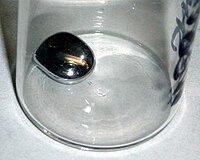Wikijunior:The Elements/Mercury


What does it look, feel, taste, or smell like?
[edit | edit source]
Mercury is a silvery metal that is liquid at room temperature. It is very dense, which means that it is very heavy even if you don't have very much of it. One tablespoon of mercury would weigh almost 8 ounces (230 grams) — this is heavy enough for metal objects like coins to float in it!
How was it discovered?
[edit | edit source]Mercury has been known since ancient times. It was known to the Chinese and Hindus. In fact, a Chinese emperor's tomb had a map of China inside, with the seas made of mercury.
Where did its name come from?
[edit | edit source]Mercury is named after the Roman god Mercurius. We call him Mercury. It is also called quicksilver because of its appearance. Its Latin name is hydgargyrum, which means "liquid silver".
Did You Know?
- Mercury is the only metal that is liquid at room temperature.
- Half of the world's mercury comes from Spain and Italy.
- Mercury has been found in 3,500 year-old Egyptian tombs.
- Mercury destroys almost any other metal, one reason it's not safe onboard an airplane.
Where is it found?
[edit | edit source]Mercury is very rare, and is mostly found in some rocks like cinnabar (mercuric sulfide, or HgS.) Most of the mercury reserves on Earth have been mined out so that there isn't much mercury left in them.
What are its uses?
[edit | edit source]
Mercury used to be used in thermometers, but mercury-in-glass thermometers are less common these days.
Mercury is also a major ingredient in amalgam fillings for teeth, typically being half of the material, but these are also less common nowadays.
Mercury is used in compact fluorescent bulbs, street lamps, and advertising signs.
The antiseptic mercuric chloride (Hg2Cl2), also known as calomel, is used to kill bacteria. Mercuric sulfide (HgS) is used to make vermilion, a red pigment used in paint. Mercuric batteries are made from mercuric oxide (HgO).
Mercury is still used today by gold miners in South America to separate gold from the powdered ore.
Is it dangerous?
[edit | edit source]Yes. Mercury is very poisonous. Mercury can enter the body through the respiratory tract (as mercury vapor), digestive system or skin. Mercury builds up in the body which eventually leads to illness or death. Mercury poisoning is called mercurialism. Mercury pollution is a problem because it can get into our food, especially seafood, where it forms toxic dimethyl mercury ((CH3)2Hg), which poisons anyone who eats seafood contaminated with it. Fish have a lot of mercury in them because they are high on the food chain, and therefore accumulate mercury from all the smaller fishes they eat. That is why eating too much salmon or tuna can be bad for you.
Mercury does not poison right away, but rather it is toxic, and can cause brain damage.